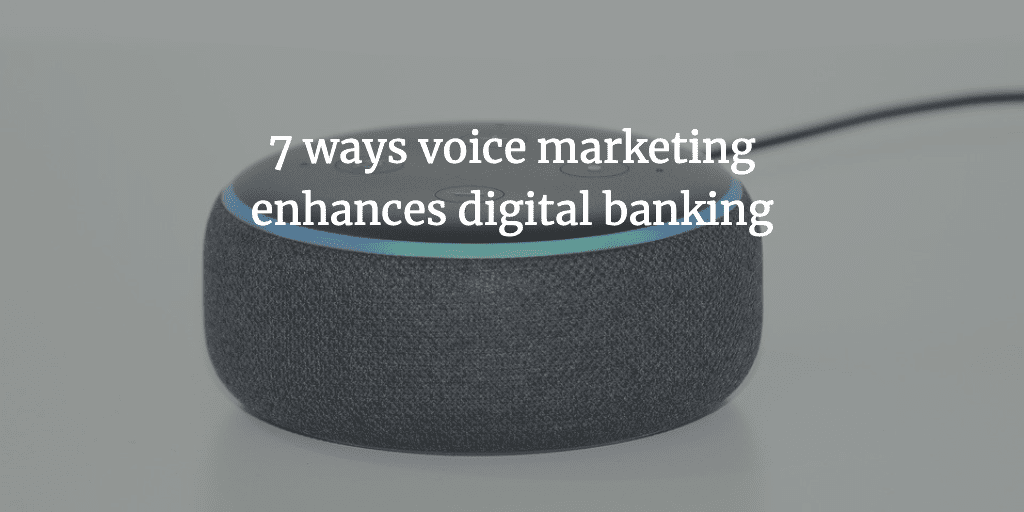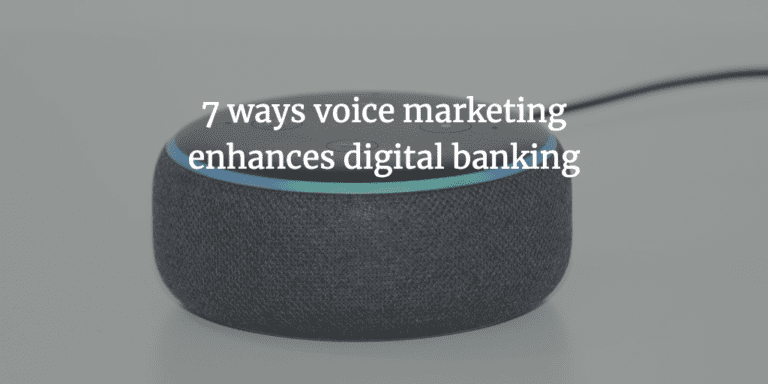
[Editor’s note: This is a guest post from direct response marketing veteran Mike Gunderson. He founded Respond Fast™ in 2018 to create the first Voice Activated Call To Action™ (VACTA) technology using smart speakers and digital assistants to respond to offline media campaigns deploying direct mail, TV/radio spots, print ads, collateral, billboards, signage and product label/packaging. VACTA enables banks to easily set up and launch a campaign using a custom phrase or code for frictionless consumer response.]
Digital banking is all about making customer experiences faster, easier and more engaging. Voice response marketing through smart speakers and digital assistants is increasingly the go-to bank marketing channel for “on-the-go-go-go” consumers.
Make it frictionless
To access financial and account information, respond to calls to action and offers, register reviews, handle transactions or reach out for help, voice response marketing is gaining in popularity. Instead of having to type in a website URL, focus on a QR code, or click on a text link, all of which can cause respondents to procrastinate, the frictionless availability of smart speakers and digital assistants encourages in-the-moment action. That can make the difference between closing a sale and losing the prospect altogether.
Consumers reach out to Google Home, Alexa, Google Assistant and Siri to get what they need more often and easily every day. Maria Allen, Unisys Vice President Global Head of Financial Services, describes digital banking that occurs “anywhere, anytime, on our own terms,” in her article entitled, “Embedded Banking: The Future of Digital Transformations.” Voice response marketing is truly driving banking that’s anywhere, anytime on consumers’ terms.
Here are 7 ways voice response marketing can favorably impact digital banking experiences:
1. Make it personal.
Customers today expect simple, personalized experiences that align with the frictionless nature of voice response. A recent Forbes.com article addresses the issue: “One regional bank realized that its new customers felt overwhelmed by the multitude of potential products and offerings. It redesigned its onboarding journey and incorporated a ‘Help Me Decide’ tool, which asks customers a number of questions about their individual needs and then generates a set of customized recommendations based on their responses. The personalized nature of these suggestions makes customers feel more competent and confident in their decisions, leading to a 4x increase in the number of new customers who actually complete the application process.”
2. Provide convenient account and location information anywhere/anytime.
Global Fintech and payments company Fiserv notes that the, “Voice-Activated Banking Market Is Ready for Early Adopters.” On its website, Fiserv points out, “If it feels like an explosion of voice-activated devices has taken place in the last year, it’s probably because it’s true. New research from Fiserv shows more than half of consumers (57 percent) are now using voice-activated services… This is a market-ready for innovators and early adopters who are looking to gain market share and to be perceived as the go-to provider.”
The Forbes article looks at another banking convenience issue where voice marketing can improve, expedite and resolve issues: “When we asked customers which aspect of banking most needed improvement, 15% identified finding a convenient branch location as the most problematic, while 9% selected using online self-service and resolving a customer service issue. The fact that the biggest experience gaps span in-person, digital, and contact center interactions is noteworthy – and a good reminder to banks that they must consider customer experience across all of their channels, not just one.”
Bankinnovation.net identifies another area where voice activated response can improve the “anywhere, anytime” experience: “TD Ameritrade launches in-car investment ‘experiences’ using voice, AI… With average commutes in the U.S. lasting around 27 minutes and with millions commuting for at least an hour per day, TD Ameritrade wants to seize the opportunity to reach a captive market…the company rolled out a series of digital tools to help customers manage their portfolios while driving…”
3. Build brand presence, influence and trust.
Many brands have initiated entertaining and emotionally appealing campaigns that speak to user experience, wants and needs rather than making a product or service sales pitch. Using voice activated marketing, banking brands can extend impact by speaking in ways that convey different emotions, expressions and even age-related commentary.
This can pay a variety of dividends to the bank, including encouraging consumers to provide feedback that gets incorporated throughout the customer experience process. Notes Forbes, “By sharing customers’ changing emotional states as they move through the app, the bank ensures that its designers are deliberately creating positive, engaging experiences.”
4. Problem-solve before customers go away.
Forbes addresses “Losing business because of poor experiences. Although only 6% of consumers who interacted with a bank over the previous six months say they had a bad experience, of those customers who did have a negative interaction, 42% of them say they either decreased or stopped spending with the bank after that poor experience.” Voice activated surveys and ratings can offer a valuable conduit to help prevent or solve problems quickly because they’re frictionless—in contrast to other problem-solving avenues.
5. Express opinions, vote for what resonates.
Voicing thoughts in the moment—happy, sad or mad—can carry much more clarity than writing, the impact of which can be lessened by poor grammar and sloppy construction. For many, vocalizing can come across much more eloquently and clearly, and when it’s in the moment, isn’t as subject to loss of focus or recall. It’s just more authentic.
The Forbes article notes the importance of providing an easy way to, “Continuously learn what customers are thinking and feeling. To deliver consistently positive experiences to customers, companies must first capture and analyze an ongoing flow of feedback and behavioral signals from key customer segments at moments of their experience. Understanding how customers are thinking and feeling about their interactions with the company – and marrying that information with operational data like products owned and interaction history – allows organizations to identify existing pain points, uncover opportunities for desirable new offerings, and proactively close experience gaps.”
6. Provide an easily accessible global platform for those with visual and other challenges.
This presents both enlightened socially-conscious and massive marketplace opportunities. Nasdaq.com looks at the marriage of smart speaker growth with billions of disadvantaged people worldwide: “The global smart speaker market grew at an impressive pace of 44.9% to reach 28.6 million units in Q3 2019…smart speakers can contribute immensely…for the visually impaired, uneducated and the elderly by making their interaction with technology much simpler. Globally, at least 2.2 billion people have a vision impairment or blindness [per] the World Health Organization.” And now, with contagion the subject of worldwide discussion, a way of communicating that doesn’t involve touching a potentially germ-filled device is an attractive option.
7. Gear up response to direct mail and other offers.
A customer or prospect gets a mailer with a loan rate call to action that gets tossed in a pile for “later” response (and is forgotten). In-the-moment voice activated response via code or phrase prompts that recipient to engage with the offer, question, idea or suggestion. Improved response and sales result.
For digital banking, voice response marketing offers myriad ways for consumers to get engaged and excited—in turn driving competitive advantage, influence and profits.


